Text
Writing References: Character Development
50 Questions ⚜ "Well-Rounded Character" Worksheet
Basics: How to Write a Character ⚜ A Story-Worthy Hero
Basics: Character-Building ⚜ Character Creation
Key Characters ⚜ Literary Characters ⚜ Morally Grey Characters
Personality Traits
5 Personality Traits (OCEAN) ⚜ 16 Personality Traits (16PF)
600+ Personality Traits
East vs. West Personalities ⚜ Trait Theories
Tips/Editing
Character Issues
Character Tropes for Inspiration
Tips from Rick Riordan
Writing Notes
Allegorical Characters
Binge ED
Childhood Bilingualism ⚜ Children's Dialogue ⚜ On Children
Culture ⚜ Culture: Two Views ⚜ Culture Shock
Emotional Intelligence ⚜ Genius (Giftedness)
Emotions ⚜ Anger ⚜ Fear ⚜ Happiness ⚜ Sadness
Facial Expressions
Fantasy Creatures
Happy/Excited Body Language ⚜ Laughter & Humor
Hate ⚜ Love
Health ⚜ Frameworks of Health
Identifying Character Descriptions
Jargon ⚜ Logical Fallacies ⚜ Memory
Mutism ⚜ Shyness
Parenting Styles
Psychological Reactions to Unfair Behavior
Rhetoric ⚜ The Rhetorical Triangle
Swearing & Taboo Expressions
Thinking ⚜ Thinking Styles ⚜ Thought Distortions
Uncommon Words: Body ⚜ Emotions
Voice & Accent
Writing References: Plot ⚜ World-building
8K notes
·
View notes
Text
I start with the truism that each Christian’s prayer life, like every good marriage, has in it common factors about which one can generalize and also uniquenesses which no other Christian’s prayer life will quite match. You are you, and I am I, and we must each find our own way with God, and there is no recipe for prayer that can work for us like a handyman’s do-it-yourself manual or a cookery book, where the claim is that if you follow the instructions you can’t go wrong.
Praying is not like carpentry or cookery; it is the active exercise of a personal relationship, a kind of friendship, with the living God and his Son Jesus Christ, and the way it goes is more under divine control than under ours. Books on praying, like marriage manuals, are not to be treated with slavish superstition, as if perfection of technique is the answer to all difficulties; their purpose, rather, is to suggest things to try.
But as in other close relationships, so in prayer: you have to find out by trial and error what is right for you, and you learn to pray by praying. Some of us talk more, others less; some are constantly vocal, others cultivate silence before God as their way of adoration; some slip into glossolalia, others make a point of not slipping into it; yet we may all be praying as God means us to do. The only rules are, stay within biblical guidelines and within those guidelines, as John Chapman puts it, “pray as you can and don’t try to pray as you can’t.” J.I Packer
124 notes
·
View notes
Text

my moon lady knight got a redesign (and i should really come up with a name)
1K notes
·
View notes
Text
Tips for Fight scenes #1
Consider how each character's personality, background, and motivations would influence their fighting style and tactics. A character who is impulsive might rush into a fight without thinking, while a more strategic character might carefully plan their moves. Use the fight scene as an opportunity to reveal hidden depths or conflicts within the characters.
Take advantage of the surroundings to add dynamism to the fight. Characters can use objects in the environment as weapons or shields, or they might use the terrain to gain tactical advantages. Think about how the setting could influence the flow of the fight and make it more engaging for the reader.
Describe the sights, sounds, smells, and sensations of the fight to immerse the reader in the action. Instead of just focusing on the physical movements of the characters, bring the scene to life by painting a vivid picture of the entire sensory experience. For example, describe the metallic tang of blood in the air or the adrenaline-fueled pounding of the characters' hearts.
Ensure that the fight scene serves a purpose beyond just showcasing action. It should advance the characters' emotional journeys or the overall plot of the story. Consider how the outcome of the fight will impact the characters and their relationships, and use it as a catalyst for further developments in the narrative.
Don't limit yourself to traditional weapons or fighting styles. Research different martial arts, historical combat techniques, and improvised weapons to add variety and authenticity to your fight scenes. Think about how each character's unique skills and resources would shape their approach to combat.
Use pacing, suspense, and foreshadowing to build tension leading up to the fight. Hint at the conflict to come, then gradually escalate the stakes as the scene unfolds. Consider incorporating moments of uncertainty or doubt to keep the reader guessing about the outcome.
Every character should have strengths and weaknesses that come into play during the fight. These vulnerabilities could be physical, emotional, or psychological, and they should add depth and complexity to the conflict. Think about how each character's flaws or insecurities might be exposed under pressure.
Show the aftermath of the fight and the impact it has on the characters and the world around them. This could include physical injuries, emotional trauma, or changes in the balance of power between characters or factions. Use the fallout from the fight to drive further conflicts and developments in the story.
1K notes
·
View notes
Text
Skyward Sword Skyloft Aesthetic
I love the aesthetic of Skyloft so let's analyze it and see what makes it tick. This will be a long post with lots and lots of photos.
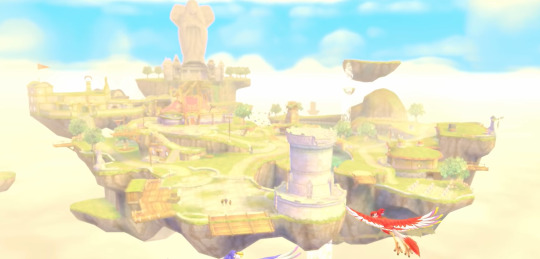
First of all, In Skyloft there are two very different styles of architecture:
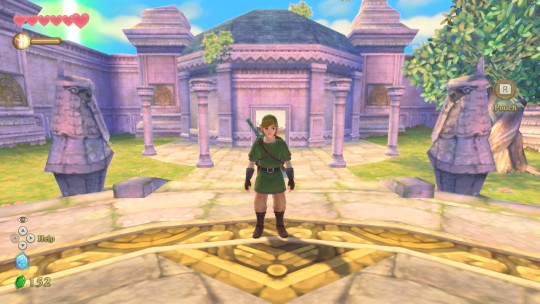
Ancient architecture, which are the stately grey stone structures like the light tower in the plaza and around the Statue of the Goddess (as well as various locations on the surface)

And the Skyloftian architecture, which is much more round, colorful and whimsical than the ancient architecture. I will be focusing on the Skyloftian architecture.

Skyloftian houses are built underground with one exposed side facing out. The roofs are flat and often have paths or grass growing on them in order to maximize surface area and places to walk. Each house is unique and is personalized to the occupant.

Non-house buildings like the bazaar, knight academy, and the Lumpy Pumpkin are built above-ground and have varying kinds of roofs, from wood to bamboo, to tented rugs.

Interior walls generally follow this pattern: the walls are painted (or possibly frescoed) with a primary color--it's not a solid color, but with a dappled 'paintbrush-stroke' pattern. Decorative stones or tiles of a contrasting color are placed in a horizontal wavy line in the bottom half of the wall and in another line near the ceiling.
At the base, is a layer of stones of a different color. Structurally, this is likely a foundational base on which the walls are constructed to protect them from groundwater damage, like in cob (a certain kind of mud-cement) house construction.


Buildings and rooms tend to be curvy or round and often have whimsical features built in, like the oven in the kitchen and the bird faucet and tiled round bathing pool in the bathroom of the Knight Academy. In houses, sinks and counters are sometimes built into the wall. This is another feature you see frequently in cob house construction.
In fact, the Skyloftian style of architecture seems to have taken heavy inspiration from cob house construction. Cob is a building material that is made of local mud with additives to turn it into cement with hay or grass mixed in. The cob is mounded up into the shape of the walls and sealed with sealant and plaster. It is very quick to construct cob buildings and they are highly customizable. Building made of cob tend to be whimsical--look up images and see for yourself.

Furniture is made with wood and often has decorative tiling, painting, or carvings in them.
In terms of decorations, the most common motifs are geometric designs, floral and plant designs, and bird-themed designs. Bright colors are preferred, and almost everything in the whole game, but especially in Skyloft, has a pink or purple tinge/undertone to it.


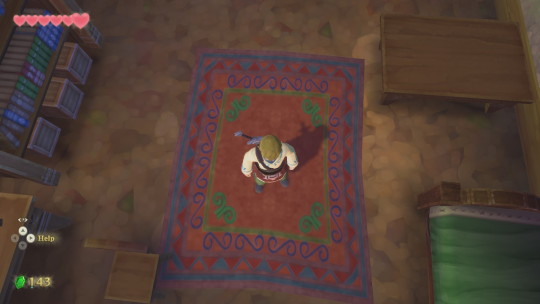


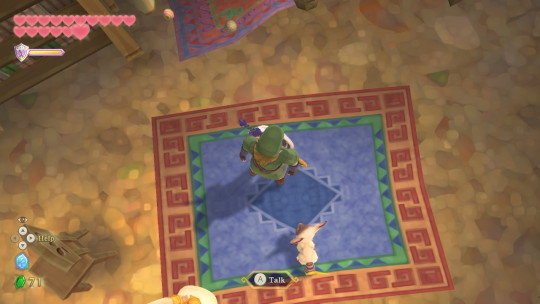
One thing Skyloftians love are ornate rugs. Every room and every house has a rug, usually multiple rugs. Each rug is unique, brightly colored, and usually geometric in design.

There is even an entire (unmanned) shop in the bazaar full of rugs and other textiles.
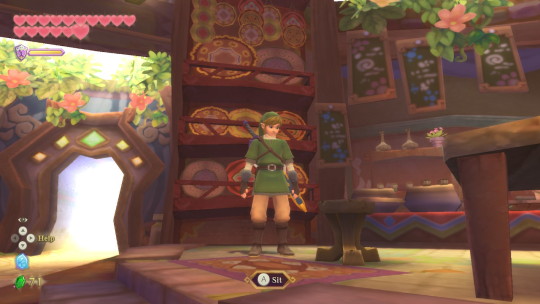
Other decorations you might find in homes and buildings are pots, vases, bottles, and plates with colorful designs

Lace, stuffed animals, decorative pillows

Turkish lamps, wall hangings, table placemats or a table runner

Mobiles and decorative ceiling hangings
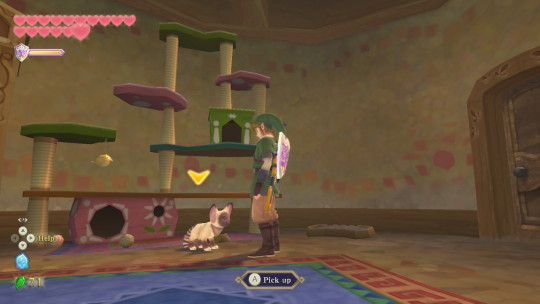
Remlit tree


And some rooms/houses are themed, for example, Fledge's room has a tropical island theme.
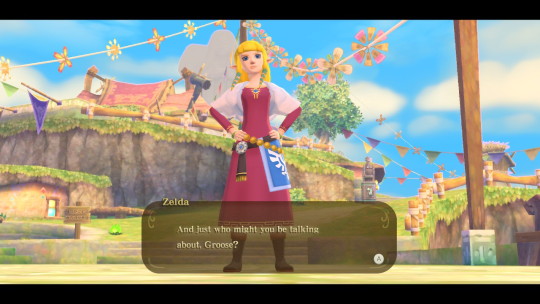
Outdoors, the village is decorated with multi-colored banners, buntings, pinwheels, flags, and flowers.

Together all these things construct the aesthetic and style of Skyloft: rounded and curvy buildings, cob-style construction, geometric, floral and bird designs, bright colors, ornate rugs, pots, Turkish lamps, stained glass, wood carvings, and lots and lots of whimsy.
122 notes
·
View notes
Text
Who wants some fun facts about our upcoming, multi-chapter LU fic, Shadowed!
It's a murder mystery/psychological horror
It will have an MCD tag (permanent? Temporary? Faked their death? Who knows! 😉)
Main POV will come from Wind and Shadow
This is technically a 'Link meets the Chain' fic (but which Link?)
Vidow is central to the plot
Wind being able to see Ghosts is central to the plot
There will be illustrations
Anything you'd like to add to this @not-freyja ?
#Every time I read something y'all put out about Shadowed I have several reactions#Noooooooo! The boys are so sweet#But this is probably going to be so beautiful#But haven't you put them through enough in the teaser images alone?#Genuinely can't wait for this collab
102 notes
·
View notes
Text
A healthy habit I wanna do more is just telling God: I love you. I praise you. You gave me life, you chose me to walk on this earth, to experience life, the gift of existing as myself, and that is crazy, that is gigantic, of all the billions and billions of possible humans to bring to life you made me. The number of people that could be created is infinite, yet here I am. Thank you. My existance is proof enough of yours.
2K notes
·
View notes
Text
147 notes
·
View notes
Text
Structuring Your Relationship Plotline: Key Beats
Beat sheets are valuable tools for structuring and writing a story. They can be just as valuable when structuring and writing a relationship arc. In reality, I could write up a beat sheet for each relationship arc. Today, I've decided to go over the key beats, in the order they most frequently appear (which usually applies to positive change relationships).
In my previous article, I laid out a foundational approach to structuring your relationship plotlines. That will likely be more useful to you in structuring your relationship arc, than following these beats in the presented order. Once you understand the foundational principles, you can successfully manipulate any beat sheet to suit what you are writing. This is why I titled this post "key beats" and not "beat sheet." There are plenty of relationship plotlines that don't adhere to these exact beats or this exact order.
Nonetheless, knowing what is most common can help you discern how to handle yours. Your relationship plotline can follow this exactly, or you can vary it (which I'll talk about more at the end).
So far, we have covered relationship arcs, relationship plots, and the foundational approach to relationship structure. Let's finish this up with the common key beats.
In this ongoing relationship series, I intentionally picked relationship arcs that appear quite different from each other, to show variation. For this reason, I'll be using Monsters Inc. as a main ongoing example below, while simply referencing some beats in my other ongoing examples; Monsters Inc. follows these beats, in this order, exactly. (Many of my other examples, do not.)
(Note for below: "Character A" and "Character B" can be either character in the relationship.)

The Meet Cute
The term "meet cute" comes from romance, and it's essentially what it sounds like. It's when the love interests meet, usually in a memorably cute way. Common (and cliche) tropes of this include Character A dropping all her papers so Character B can help her pick them up, or Character A being clumsy and/or tripping in front of Character B.
I've talked about meet cutes before, and have related it to other types of relationships, so here, I'm going to expand it to that. When I read Romancing the Beat, I was happy to see that Gwen Hayes was fine with expanding the definition as well. Hayes talks about how, even if the characters already know each other before the story starts, the Meet Cute beat is the first time the audience sees them on the page together.
Regardless of what the relationship is or how long it's been going, we want to use this beat to convey where the characters stand with each other. Are they strangers meeting for the first time? Sworn enemies and rivals? Siblings turned best friends? If you are working with a relationship that started before the story, you can check out "How to Convey an Established Relationship Quickly" for some tips.
As long as the Meet Cute conveys where the characters stand, some feel that it does not need to be fancy or original. It can happen when one character hails a taxi. It can happen when Character A accidentally shuts the door on Character B.
While this surely can fulfill the Meet Cute function fine, I sometimes feel that settling on something trite is a missed opportunity (unless, of course, triteness is the point). Just as we want a strong characteristic moment to introduce our protagonists, we should--ideally--aim for a strong, individualized Meet Cute to introduce the central relationship. Consider: What makes this relationship special? What makes these characters unique?
I like it when the writer goes beyond a "stock" Meet Cute. When Sherlock and John meet, Sherlock uses his classic reasoning of deduction to figure John out. That's a meeting only Sherlock can have. It's not a stock meeting. It also does double duty by showing off Sherlock's character.
In Monsters Inc., Sulley and Boo have their own unique Meet Cute. Sulley is terrified of her, and she's only a happy, excited toddler. We immediately know where the characters stand with each other.
Is the Meet Cute the Inciting Incident?
There is some debate as to whether or not the Meet Cute is the inciting incident of the relationship plotline. I think this depends on how the Meet Cute goes.
Let's remember that an inciting incident is a (medium-sized) turning point that disrupts the established normal, sending the plotline in a new direction.
Does the Meet Cute do that?
If the answer is "yes," then it's also the inciting incident.
If the answer is "no," then the inciting incident probably comes later.
In relationships, a turning point is often marked by a vulnerable moment (i.e. Character A tripping, Character A dropping all her papers, Character A having the door slammed on her), followed by Character B's reaction to it (accept, reject, or neglect). If your Meet Cute has that, chances are it's the inciting incident (especially if Character B's response is something that hasn't happened before).
With that said, sometimes a writer can use a vulnerable moment to convey where the relationship currently is, so it doesn't really change any major trajectories. . . . There are definitely some gray areas.
The inciting incident is usually seen as an opportunity or a problem (or both) for the protagonist. If a character wants to draw closer to another character at this point, then it's an "opportunity." If a character wants to create distance, then it's a "problem."
So, if your Meet Cute is disrupting normal and sending the relationship plotline in a new direction, it's probably the inciting incident. Even if the characters already know each other.
For example, in The Lord of the Rings, Frodo and Sam have a Meet Cute when Gandalf finds Sam and accuses him of eavesdropping (notice this puts Sam in a vulnerable position). Rather than ultimately turn him away, Gandalf and Frodo accept and partner him with Frodo--this kicks off their relationship plotline in a new direction. They are linked more closely, in a new way.
If the Meet Cute simply illustrates the relationship, it's probably not the inciting incident. For example, Ralph Breaks the Internet opens with a long Meet Cute of Ralph and Vanellope's current relationship. In this montage, we may sense that Vanellope is looking for something more externally (and internally), but within the relationship itself, nothing is kicked onto a new trajectory.
More Writing Tips on Meet Cutes
Just as your protagonist's characteristic moment in the opening should set the tone for his plotline, so should the Meet Cute set the tone for the relationship--at least what the relationship is like at the beginning of the arc.
Since the Meet Cute is meant to convey where the relationship currently stands, use it to help set up the relationship arc. Consider: Are these characters close or distant? Do they have mutual feelings toward each other? You may be able to foreshadow what lies ahead. Maybe Character A dislikes Character B right away, but notices how attractive he is. Or maybe Character A isn't as invested in the relationship as Character B. Or maybe Character A wonders if this relationship is toxic.
Relay the POV character's impression of the other character. If this is the first time the characters are meeting, this is obviously a first impression. How is it wrong? Or how is it right? It may be that Character A gets the completely wrong first impression. Or it may be that Character B is even more crazy/attractive/clever/mean than Character A first realized. If the characters already know each other, then relay how the POV character views the other person.
With a strong relationship plotline, the audience often likes to look back fondly (or ironically) on how the relationship started. If the Meet Cute is the characters' first meeting, make it memorable. If the characters already know each other, consider filling in how the characters first met or started the relationship. It doesn't have to be in the Meet Cute beat, but I recommend filling it in somewhere. The moment where the relationship begins often feels special--not necessarily because the moment itself was amazing, but because the relationship it has grown into is meaningful.

The Adhesion
This beat most often happens near the 25% mark of the story (Plot Point 1), especially if the relationship plotline is the A Story. Out of all the beats, I feel like this moment can appear with the most variation, and so I almost left it off this article. But it is a key beat, and almost always a critical one.
Simplistically speaking, at this moment, something locks the relationship characters together in an irrevocable way. Usually, they've met, we've established how they feel about each other, and then something happens that binds, ties, or cements them together definitively, for their relationship journey.
Most frequently, one character (or both) wants to be distant, but something external glues them together. They are in a new "world" or situation and will have to figure out how to work together or get along. They may be stranded in the desert, assigned partners for a project, forced to fake a relationship, or what have you. As Gwen Hayes puts it, the story needs to be crafted so that they can't walk away from each other.
This adhesion can come from something completely external, as is the case in the above examples, or it can instead come from within the relationship itself. Perhaps the characters actually do want to be together. In 1984, Winston and Julia are cemented together in a definitive way after their first rendezvous. They want to keep seeing each other.
The Adhesion can also come from within one character. For example, a student may commit to learning from a specific mentor, no matter what. Signing up for a class from this person could be The Adhesion.
An important thing to note is that at this point, there should also be a "repellant" in play. The characters may find each other repellant, but The Adhesion forces them externally together. Or, the characters want to adhere to each other, but an external force, like the Party, threatens to pull them apart. Or one character determines to adhere, while the other character determines to repel. Or perhaps one character internally experiences both the push and pull, so makes a move to adhere, while experiencing a repelling doubt within.
Basically, to build on what we've talked about previously, the goal and the antagonistic force are both locked in, somehow. If the goal is to draw close, the antagonist is what threatens to pull apart. If the goal is to grow distant, the antagonistic force is what pushes them together. As with other plotlines, this is what officially sets up the main conflict.
The Adhesion will create a significant turning point in the relationship. This also makes the relationship somehow more personal.
And again, this can manifest in a lot of different ways.
In Monsters Inc. The Adhesion happens when Sulley is unable to return Boo to her room. After trying to do this, he goes to the bathroom to only realize she's on his back. When he enters the scare floor, Randall is putting her door away. Sulley wants to be distant from Boo (repellant), but she is now stuck with him in Mostropolis (adhesion).
In The Prestige, The Adhesion is the death of Angier's wife. Since Borden's actions are what led to this, Angier's relationship with him takes a significant turn. Angier hates Borden for it (repellant), but is also cemented to him by it (adhesion)--it's what leads him to want to exact revenge. Even if they dislike each other, their relationship becomes more personal. The drowning is what ties them together. It's what sets up the main conflict between them.
The Adhesion can happen right after the Meet Cute, as it does in Monsters Inc. Or the meet cute and The Adhesion can be spread out over a whole act, as is what happens in The Prestige. And if you want to really make your head spin, it's technically possible The Adhesion happens before the Meet Cute.
For example, a student may commit to learning from a specific mentor and sign up for his class, but may not actually meet the mentor until she attends the first class. In such a case, the inciting incident may be the initial disruption that led the student to first consider the mentor and/or class (which is another example of why the Meet Cute isn't always the inciting incident).

The Token
This beat commonly happens near the 50% mark of a story (the midpoint). This is typically a moment where the characters draw real close. In the screenwriting world, there is a saying, "sex at sixty." Page 60 is the midpoint of a typical screenplay. And that's when the love interests get intimate. But stripped of the romance (and sex), this is really a token of love and/or trust.
Character A has an intensely vulnerable moment--Character B is seeing a deeper, more vulnerable layer of Character A than he has ever seen before. This is normally accompanied by a token, or gesture. It could be a first kiss. It could be Character A sharing her ghost story. It could be a moment where Character A has to swallow her mountain of pride to, embarrassingly, ask Character B for help. It could be Character A confessing a secret. Or even feeling safe enough with Character B to fall asleep.
As you can probably tell, this is another significant turning point in the relationship.
Normally, this moment will be accepted (and often even reciprocated) by Character B. Character B kisses back. Character B shares his ghost story. Character B agrees to help. Character B confesses a secret. Character B tucks her in.
In Monsters Inc. The Token happens when Boo goes to bed. She's scared a monster is going to get her, and Sulley decides to stay in the room with her. She falls asleep. Sulley realizes that Boo isn't dangerous; he doesn't need to be afraid of her.
In Harry Potter and the Sorcerer's Stone, The Token happens when the boys take on a mountain troll to rescue Hermione, whose life is at risk. When the boys' educational standing is at risk, Hermione responds by taking the blame.
In The X-Files: Fight the Future, The Token happens after Scully reveals she plans to quit the FBI, feeling that all she's ever really done is hold Mulder back. This leads Mulder to share how much she means to him, both professionally and personally. They're both being vulnerable, to the point that even Scully is about to cry, and they (nearly) kiss for the first time.
There is, of course, room for variation. For example, in Pride and Prejudice, this is when Mr. Darcy proposes. That's his token of love and trust. Unfortunately for him, Elizabeth rejects it . . . but it still arguably makes their relationship more personal.
Typically, though, The Token brings the characters really close--it may even give them a high. Everything is going to be fine in this relationship. Or even, Everything is going to be amazing, and we'll be happy together.
How it will manifest will depend on your story and the relationship.

The Breakup
This beat is--more or less--the opposite of The Token. The Token usually draws the characters real close. The Breakup pulls them apart. While The Token is one of the most intimate beats, The Breakup is one of the most distant. Think of this as the "All is Lost" or "The Ordeal" beat of the relationship plotline. It usually hits at or near the 75% mark (Plot Point 2).
The characters have been together long enough to have shared vulnerability and build trust, but there have also been costs, doubts, and antagonistic forces. Pain-free relationships are easy. Pain-full? That is the refiner's fire.
At this point, one or both characters may be personally hurt, and in an attempt to protect themselves (or the other), push further away. There was probably a vulnerable moment nearby where someone got rejected (this may be exactly what led to The Breakup). This may have been done deliberately, but it also may have been a matter of priorities, or a "blind spot." The internal and external plotlines may also be influencing what's going on.
In relationship plotlines that are predominant in the story, we usually want to show that the characters have a choice whether to stay together or not . . . and at least one of them chooses not to. This normally connects the relationship plotline more closely to the internal plotline.
However, it's also possible that the characters still want to be together, but an external (antagonistic) force pulls them apart--the Party separates Winston and Julia. Scully (or Mulder) is abducted by aliens. This connects the relationship plotline more closely with the external plotline.
And of course, you can have some of both.
However this manifests, the point of this beat is to pull the characters apart significantly--to a degree greater or more painful than what has happened before in the story.
In Monsters Inc., Boo becomes scared of Sulley after witnessing his scare tactics, and she rejects his attempts to comfort her. Soon after, Waternoose banishes Sulley and Mike to the Himalayas. Randall and Waternoose plan to keep Boo indefinitely to extract more screams from her. All seems lost.
In The Lord of the Rings, after tension over whether or not to trust Smeagol, Frodo and Sam separate. Frodo has chosen to follow Smeagol, and has rejected Sam in the process.
In Harry Potter, Harry is physically separated from Ron and Hermione in the Forbidden Forest.
It's often effective if The Breakup comes after a high.
Typically, the characters draw real close at the midpoint, and are working very well together after--but at the same time, there are cracks of doubt and setbacks in the relationship (think of the dance). You may hit a big high that is then undermined by a big low. It's also possible to hit both more or less simultaneously.
In The X-Files: Fight the Future, after Mulder and Scully (nearly) kiss, Scully gets infected and abducted and Mulder takes a bullet and has to be hospitalized. He has no clue where she is, and the physical distance between them is at its greatest in the film.
And as you've likely noticed the pattern, The Breakup is another significant turning point in the relationship.

The Grand Gesture
The relationship plotline will have a climactic turning point (the climax), just as other plotlines. In a positive relationship arc, this beat is like The Token, but bigger. In a negative relationship arc, this beat is like The Breakup, but bigger. (Generally speaking, of course.)
Character A is even more vulnerable than before. This is (almost always) Character A's most vulnerable moment. In stories that feature a positive relationship plotline as the A Story, this should often be voluntary. Have Character A risk it all, or lay it all on the table. If the relationship is the A Story, this is for the relationship. If it's not, this may be for the external and/or internal plotlines. It may be that the other plotlines lead to Character A's vulnerability.
If this is a negative relationship plotline for an A Story, often the two characters will have a faceoff (of one sort or another). It's more likely Character A's vulnerability will be forced by Character B. If it's not the A Story, again, the vulnerability may be influenced by other plotlines.
However it plays out, this is the moment where Character A stands figuratively naked in front of Character B. This is the moment where Character A needs Character B's mercy the most.
Character B will then accept, reject, or neglect Character A in a defining way--a way that completes the relationship arc.
There are usually high stakes, and a significant gesture of love/trust or hate/distrust from at least one character.
It's also possible for both characters to be "naked" in front of each other, and then accept, reject, or neglect one another. This may happen at the same time, or Character A may have this moment, then Character B.
What matters is that this climactic turn is there, and that it is a defining beat.
In Monsters Inc., Sulley races to rescue Boo from Randall--risking not only his career and further punishment, but his life. In the final fight, Randall tries to drop Sulley to his death. Sulley is in his most vulnerable state, but Boo summons her courage to attack Randall, saving Sulley.
In The Lord of the Rings, Frodo collapses just short of the Crack of Doom. Sam carries him the rest of the way. (In contrast, Gollum attacks him.)
In The X-Files: Fight the Future, Mulder arrives in Antarctica to cure and rescue Scully, which entails sneaking into enemy territory, freeing her (note, she is, in this case, literally naked, unconscious, and freezing), and carrying her to safety when surrounded by lethal aliens.
In Revenge of the Sith, Anakin lies limbless and catches fire, but Obi-wan leaves him for dead.
In The Prestige, Borden and Angier discover the truth of each other, and Borden finishes the relationship with a bullet.
In Mockingjay, Gale tearfully apologizes to Katniss about Prim's death. Katniss bids him goodbye.
Always, you can find variation. In 1984, the relationship characters aren't near each other because they have been separated by the main antagonist for torture. At the peak of the story, Winston rejects Julia to save himself (simultaneously losing himself to brainwashing), and the relationship with Julia ends (while a new relationship with Big Brother begins).
Find the climactic moment that works best for your story and your characters' relationship. Make at least one character vulnerable like never before. Deal acceptance or rejection like never before.

The Denouement
The purpose of a denouement isn't to simply tie up loose ends, but to validate what has and has not changed because of the story--especially because of the climax. It also establishes, or at least hints at, a new normal.
If the relationship ended positively, show it to us. Give us Elizabeth and Mr. Darcy happy together. Show us Scully recommitting to the X-Files and to Mulder.
And even if the characters have to go different ways because of external or internal reasons, show that they still love and trust each other. Frodo gives Sam a meaningful goodbye.
If the relationship ended negatively, show it to us. Give us Winston running into Julia and having none of the passion he had before. Show how Katniss and Gale have become essentially strangers. At least convey the lack of relationship--like we have with Anakin and Obi-wan.
Some relationship plotlines may require variation. If one character died, this obviously changes things. But you may still convey the living character's feelings about the other person. He may carry an object or picture to remember the other, visit a grave, or take action on the other's behalf. Or, he may burn a love letter, desecrate the other's space, or act against the other's will.
Show how the relationship changed or didn't change the character. Sometimes it's nice to include a callback, particularly of the Meet Cute.
In Monsters Inc., Sulley believes he will never see Boo again, but keeps a piece of her door with him at work. Secretly, Mike fixes Boo's door for Sulley, and it is implied he visits Boo.

Structure Variations
In this relationship series, I've emphasized a lot that there is variation. When you know the rules, you can bend them to your will. When you're a true chef, you can make your own recipe.
While I've discussed which beats are included and when they are usually included, they aren't law. In fact, they have a lot of flexibility. For example, the Meet Cute often happens in Act I (and usually must if it is the A Story), but it just as often happens in Act II (when it's a B Story). Most often the midpoint is The Token, but it's theoretically possible to put The Breakup at the midpoint instead. It's also possible to put The Grand Gesture around the 75% mark, with Act III being about the external plotline.
In a story where the relationship plotline isn't the A Story, you have more wiggle room with the percentages of major turning points. For example, in The X-Files: Fight the Future, The Token technically comes after the 50% mark--the midpoint of the A Story (the external plot) happens at 50%. Since the relationship isn't the A Story, and the midponit of the A Story can't really bee romantic (the fans will get my joke), The Token can't really happen until later.
Sometimes you can hit the major turns in a relationship at the same time as the A Story's (especially if the characters are together), but sometimes you'll hit the major turns in the relationship just before or just after the A Story's. It's fine, because it's a secondary plotline.
Instead of zig-zagging the relationship from apart to close, you could technically zig-zigger it from close to closer, or zag-zagger it from distant to more distant.
If you follow the above beats, however, you will almost never get the structure wrong.
At the most basic level, just remember that each act should include a major turning point in the relationship.
Hope this has been helpful to you.
Happy Writing! (or shipping . . . )
Articles in this Series:
The 4 Basic Types of Relationship Arcs
Turning Relationship Arcs into Plots, Part 1
Turning Relationship Arcs into Plots, Part 2
Turning Relationship Arcs into Plots, Part 3
Structuring Your Relationship Plotline
P.S. In case you missed it, I will be teaching an online writing course! Yay! It is called The Triarchy Method of Story. Get all the info here.

170 notes
·
View notes
Text
show, don't tell:
anticipation - bouncing legs - darting eyes - breathing deeply - useless / mindless tasks - eyes on the clock - checking and re-checking
frustration - grumbling - heavy footsteps - hot flush - narrowed eyes - pointing fingers - pacing / stomping
sadness - eyes filling up with tears - blinking quickly - hiccuped breaths - face turned away - red / burning cheeks - short sentences with gulps
happiness - smiling / cheeks hurting - animated - chest hurts from laughing - rapid movements - eye contact - quick speaking
boredom - complaining - sighing - grumbling - pacing - leg bouncing - picking at nails
fear - quick heartbeat - shaking / clammy hands - pinching self - tuck away - closing eyes - clenched hands
disappointment - no eye contact - hard swallow - clenched hands - tears, occasionally - mhm-hmm
tiredness - spacing out - eyes closing - nodding head absently - long sighs - no eye contact - grim smile
confidence - prolonged eye contact - appreciates instead of apologizing - active listening - shoulders back - micro reactions
96K notes
·
View notes
Note
That makes soooo much sense. I was guessing Appalachian with all the ain'ts peppered in but I'm not too familiar with the accent so hard to be sure.
Also for the ask game for my recovering mental state could I get a 12 for Twilight? Or dealers choice if you don't have one for Twilight specifically?
12. What's a headcanon you have for this character?
Of course I have one for Twilight! I have several for Twilight!
First of all, he has an thick Ordonian accent, and tries hard to cover it up because of the classism/xenophobia in his Hyrule. I have decided unilaterally that an Ordonian accent sounds like an Appalachian accent.
I will not be taking constructive criticism at this time!
Also… your mental health is recovering, you say? That’s great! Don’t mind me I’m just going to type faster now!
#hi frejya!#It's ok#I've moved on from gaslighting myself#I now just distract myself with trying to predict what will happen based on my extremely fast and loose knowledge of actual LOZ canon#I've shown too much weakness#I've handed you a knife#I am once asking you to leave PSL boi alone
9 notes
·
View notes
Text
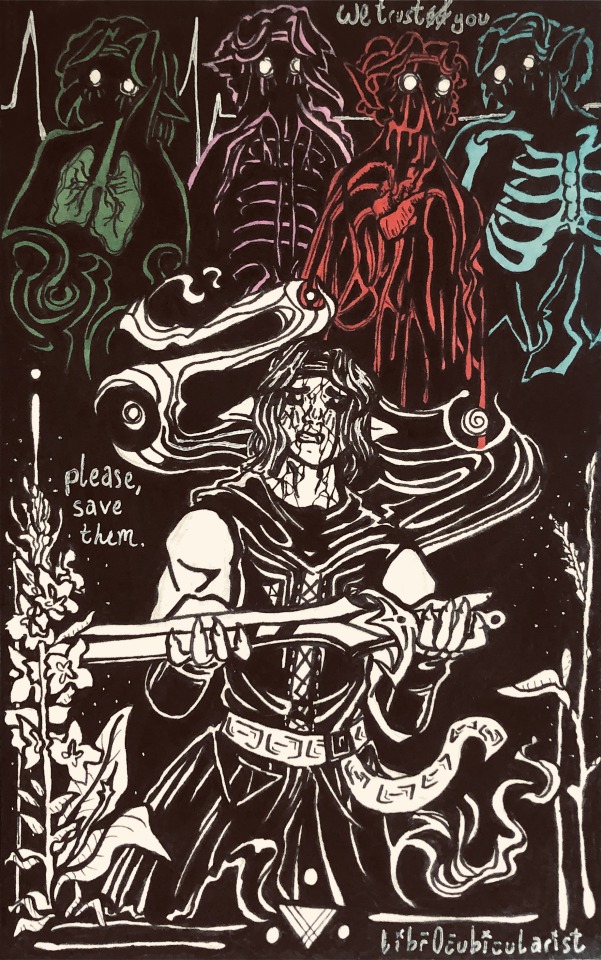
I do not know what is fucking happening. I just doodled something based off the scraps of context we’ve been given. anyways. @gia-d and @not-freyja I’m very excited to see you hurt the boys :D
298 notes
·
View notes
Text
I like the general fandom trend to just take the plot of Hyrule Warriors as a loose guideline at best and just use the whole concept as a good excuse to get blorbos to interact across timelines, BUT I'm very disappointed that everyone is missing the comedic potential of a very specific squad of characters:
Young Link (aka Mask), who walks out of the nightmare of Majora's Mask and immediately gets portal kidnapped into a temporal war, takes one look at the whole mess and decides that you could not fucking pay him to admit to being the resident expert on Time Shenanigans. He introduces himself with the title of Hero of Termina, and definitely doesn't have any other ones, that would be crazy. Hero of Time? Never heard of him.
Tetra, who is a kickass pirate captain with zero patience for people trying to shove her into the Designated Princess role, and realizes immediately that Oh Fuck, this Hyrule has a lot of Ideas about how the Hero and the Princess are supposed to properly play their parts, the second they realize she's technically a Zelda they're gonna shove her in a goddamn dress and damsel her again, that's not happening. So she's definitely just a really cool pirate captain, nothing else going on here at all, definitely not the heir of the Hylian royal family in her time, that'd be crazy.
Ravio, who is literally just a palette swapped Link, meaning that the second his hood comes off, things are gonna get Awkward. There's no way in hell he's dealing with all that Hero baggage, that's Link work, so that giant bunny hood/mask is practically superglued to his head, and he's not taking it off for love or money.
Spirit Tracks Zelda, who is just in the Phantom Armour the whole time, and passing herself off as just a friendly ghost posessing a suit of armour to help the Hero of Spirits. Of course she isn't Princess Zelda, that's ridiculous, if she were a Zelda then people would start getting really weird about her technically being dead, and boy does that ever sound like a whole Thing she doesn't want to deal with, so she can't possibly be Zelda, she's just a nice ghost knight. Also, her teenage grandma is here, and that's kinda weird, so it's easier to just not admit to being royalty and avoid that awkward conversation.
Finally there's Sheik, who is not the Princess Zelda of the era straight up abandoning her war torn country for months at a time so she can risk her life in extreme cosplay for no clear reason, but is instead the actual Sheik from Ocarina of Time, who just beat Ganondorf like a month ago and is still trying to process what the fuck to do now. Also, he's been pretending to be a boy since he was ten, and is realizing there's a pretty good chance that he isn't pretending anymore, so that's a whole other can of worms. But for the last seven years of his life, being Princess Zelda meant certain death, so he's not really inclined to introduce himself like when in a new and stressful situation (not to mention he might actually just not be a girl named Zelda anymore), so he automatically introduces himself as just Sheik the spooky ninja man, and fuck he's in too deep to back out now, looks like he's committing to the bit. If you think you sense the Triforce of Wisdom on him, no you don't.
Cue shenanigans as the five of them attempt to hide that they're all actually kind of A Big Deal. The group motto is "Nobody says shit", which is usually delivered as a frantic hiss whenever someone slips up. Just the reunion between Sheik and Mask alone would be absolutely buckwild given how they parted, and how they're both frantically pretending to Not be involved with each other. For added hilarity and/or drama, Sheik gives his semi-bullshit cover story of having just been a friend of the Hero of Time, then runs into said Hero of Time and they both have to desperately pretend not to know each other, because if anyone picks up on the mountain of baggage between them then Mask is busted, and he won't hesitate to drag Sheik down with him out of sheer spite. Not to mention the weird balance of Sheik being used to this Link being a teenager that's actually a small child, and now has to adjust to Link who is a small child that's actually a teenager.
Also, i really feel like we're all missing out on the comedy potential of Ganondorf recognizing Young Link on sight and the two of them immediately launching into a grudge match with some extremely personal and specific insults on both sides. Meanwhile literally everybody else is just standing there watching, trying to process the fact that out of every single person that's been pulled out of time, Ganondorf only has personal beef with a literal nine year old.
I just feel like we're all really sleeping on the potential for Shenanigans here. The whole thing is an absurd mess, why not have some fun with it?
654 notes
·
View notes
Text



some oot link and sheik doodles
ceiling wars:

3K notes
·
View notes






